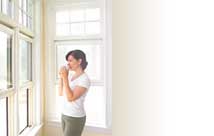Window Replacement: Stop home energy dollars from leaking out your walls
| Tweet |
When building a new home, buyers are often aware of common heating and cooling problem areas, such as windows and doors. Many will ask their builder about double- or triple-pane windows, insulated doors and the quality of insulation, without considering the impact of wall construction on home energy efficiency.
"Energy efficient construction should address air, moisture and thermal movement through walls, as well as floors, ceiling and roof," says Rob Brooks, green buildings program director for iLevel by Weyerhaeuser.
Building codes increasingly call for tight construction, yet many modern homes are built with decades-old framing practices that can leave substantial gaps where air can leak into or out of the house. For example, wall studs and floor joists placed at unmatched intervals, single studs at corners, and window openings with multiple, rather than single-piece members, can leave voids that are difficult to reach with insulation. As with gaps under improperly sealed doors, these un-insulated openings provide a path for air to leak from the home. Furnaces and air conditioners must make up the difference to maintain a comfortable indoor temperature.
"The good news is that advanced framing techniques for a tight home are simple and cost effective," says Brooks. "It's a matter of educating builders on the latest framing methods and design software that makes the best use of pre-planning. Tools like iLevel Javelin design software at their lumber dealer can show them how to best place all of the framing members for a more continuous fit with the insulation." (For more information on structural framing solutions, visit www.ilevel.com or call (888) 453-8358 to speak with an iLevel by Weyerhaeuser expert.)
Advanced framing techniques can increase the overall insulating properties of a completed wall by up to 58 percent and allow for 86 percent greater insulation volume when comparing a 2-by-4 to a 2-by-6 wall with the same type of insulation. At the same time, less wood is needed because the larger 2-by-6 studs are spaced farther apart. The result is walls that block heat and cold better, use fewer materials and are stronger than those built using conventional practices.
"More buyers are interested in green or energy efficient homes," adds Brooks. "Framing methods that aid energy efficiency not only are environmentally responsible, they can also help homeowners save money."
Courtesy of ARAcontent.


|
Respond Home Improvement Directory lists the top Replacement Window Contractors in your area, organized by specialty and office location. |
| Top Cities | |
|
Atlanta
Chicago New York |
Los Angeles
Philadelphia Washington DC |
| Canadian Cities | |
|
Calgary
Edmonton Ottawa |
Toronto
Vancouver Winnipeg |





